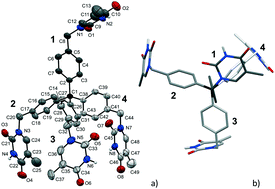2-D and 3-D porous structures from tetrakis(4-thyminylmethylphenyl)methane†
Abstract
Using tetraphenylmethane as a scaffold, a potent hub for generation of organic porous networks has been synthesized by introduction of thymine functionalities in all para-positions. Depending on the choice of solvent, crystal structures are produced with 35–46% solvent volume organized in two- or three-dimensional channel systems. The intermolecular interactions are dominated by two features: formation of dimers connected by six C–H⋯O hydrogen bonds, and links between these dimers as R22(8) ring motifs formed by pairs of thymines. These are the first structures of their kind and suggest further use of DNA-inspired building units in supermolecular engineering of biocompatible functional materials.



 Please wait while we load your content...
Please wait while we load your content...